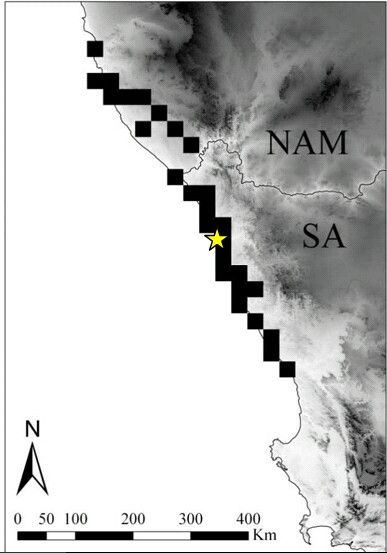Post by Ceratodromeus on Jan 15, 2016 1:25:54 GMT 5

Scientific classification
Kingdom: Animalia
Phylum: Chordata
Subphylum: Vertebrata
Class: Reptilia
Order: Squamata
Suborder: Serpentes
Family: Viperidae
Subfamily: Viperinae
Genus: Bitis
Species: B.schneideri
Description
This species of venomous snake is very small, and has a body coloration that allows it to expertly blend into its habitat. A typical adult animal has a dark and light brown coloration, intermittently broken up by black spots with white or grey centers. The underside of the species is also white. The scales (dorsal and midbody) are keeled, which also aids in camouflaging in their environment so they are not conspicuous when viewed from above. Adult animals measure approximately 191-207mm(7.5-8.1in)in snout-ventral length; total length in adults is approximately 210-231mm(8.2-9in); these snakes weigh about 15g(0.5oz){1}; the largest recorded individual measured 251mm(9.8in) in snou-ventral length and weighed 38g(1.3oz){1}. The species is ssexually dimorphic, with females attaining greater lengths, having larger heads, and weighing more then conspecifics makes.

Geographic distribution
This species can be found on the southwest coast of Africa, ranging from Namibia to coastal Namaqualand, and areas where s udies of the species focus mainly on the Northern Cape Province. It is found in large sandy areas, particularly dunes with some herbaceous cover. They are fairly sedentary snakes and do not occupy very large home ranges, and occur at relatively high(for a viperid, anyway) densities{1}.

Dietary habits
Like other members of the bitis genus, this dwarf adder is a sit and wait ambush predator. It has been documented burying itself in sandy substrate, and will wait for extended periods of time in this position for a hapless lizard or small mammals to wander by. Species taken as prey include Knox's Ocellated Sand Lizard (Meroles knoxii), Namaqualand rain frogs (Breviceps namaquensis), variegated skinks (Trachylepis variegata Austen's thick-toed geckos (Pachydactylus austeni, and Namaqua dwarf chameleons (Bradypodion occidentale){1}.

Reproduction
As a result of their small body size, this species has a relatively short life span and thus, reach sexual maturity quickly. Females and males of the species are known to achieve sexual maturity at 10-15 months of age, and reproduce by their second spring. Litter size(as these snakes bear live young) is, of course, consequently small as well, with a typical litter numbering three{1}. There is no degree of parental care, and the young are independent as soon as they are born.

Reference
{1} Maritz, Bryan. Ecology of the Namaqua Dwarf Adder, Bitis schneideri. Diss. Faculty of Science, University of the Witwatersrand, Johannesburg, 2011.


